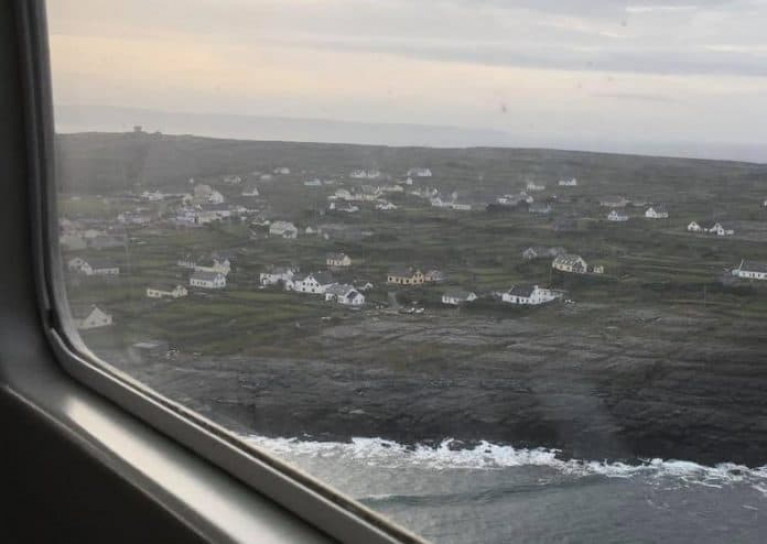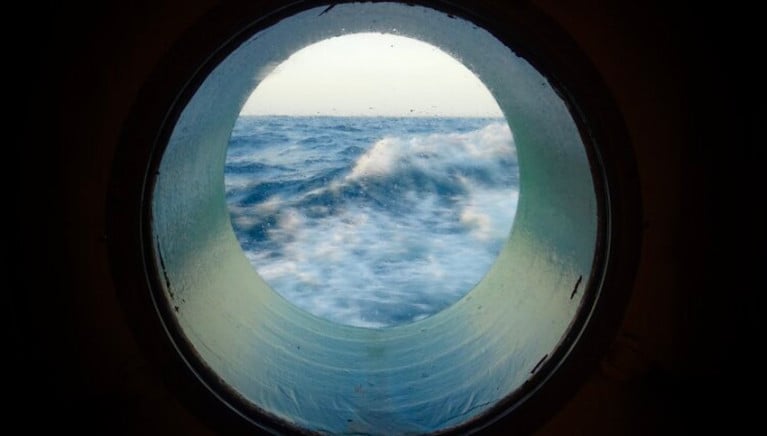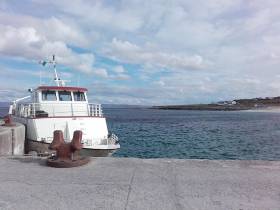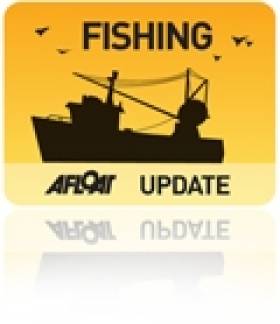Displaying items by tag: Inis Oírr
Islanders with expertise in stone have completed a “jigsaw puzzle” of rock upon timber for an Irish language production of Beckett’s Happy Days on the Aran island of Inis Oírr.
As The Times Ireland reports, director Sarah Jane Scaife worked with designer Ger Clancy and a number of islanders to construct the outdoor set in preparation for the Galway International Arts Festival.
“We all have experience of building stone walls, but this was different,”Inis Oírr resident Matt Seoighe said.
“Tomás Noel Sharry was our stonemason, and five of us worked together in a field at Creig an Staic, and it was difficult enough,” Seoighe said.
Actors Bríd Ní Neachtain and Raymond Keane have been cast as Winnie and Willie for Laethanta Sona, which was translated by Michéal Ó Chonghaíle.
“I’ve been coming here for 28 years and have always been inspired by the place, which is both surreal and existential” Scaife explained.
“My husband, late sound engineer Tim Martin fished from here, my children have been coming since they were small - and after Tim died, so many islanders came for his funeral,”she said.
“So “Beckett sa Creig”, as we call it, has been 28 years a bubbling,” she explained.
Island photographer Cormac Coyne worked with Scaife for the production, which is a collaboration between Company SJ and the Abbey Theatre.
Costumes created by Sinead Cuthbert were inspired by flowers that grow between the cracks in the rock, as Winnie herself appears from the cracks in the rock.
An accompanying exhibition in the island’s arts centre, Áras Éanna documents the building of the set and interviews and photos with women on the island.
Curacha, the exhibition of currachs used as canvases by artists, is also continuing at Áras Éanna and on an outdoor trail until September 12th.
Tickets for the Inis Oírr production of Laethanta Sona from August 30th to September 5th have already been booked out.
However, the play will be performed with subtitles at the Dublin Theatre Festival from October 14th to 17th, with online booking from August 24th.
Read The Times Ireland here
Aran Island Suffers Water Shortage
The Aran island of Inis Oírr is facing a water shortage with night-time rationing introduced this week.
As The Times Ireland edition reports, Irish Water and Galway County Council have appealed to the islanders to conserve water for essential use.
Night-time restrictions came into place last night (May 3) from 11 pm to 7 am and will remain indefinitely. Tourism has not yet resumed on the island, although several school tours have taken place within county boundaries.
Inis Oírr, which is the southernmost of the three Aran islands with a population of just under 300, has experienced periodic water shortages over the past decade.
It has had to receive shipments of water to relieve the situation during the summer months.
However, the extent of this shortage at an early stage of the year and with few visitors due to Covid-19 has taken the community by surprise.
Although many elderly and vulnerable islanders are now vaccinated, there is also concern among residents about the availability of water for hand-washing during the pandemic.
It is understood a site was acquired for new storage tanks and it was then deemed too expensive to construct them.
Irish Water says it is committed to a “ long term solution for the provision of drinking water on Inis Oirr”, which “will be developed” as part of a national water resources plan.
However, it is expected this will take some time, as submissions on a national draft framework plan for water resources are currently being reviewed.
Sewage Treatment on Inis Mór
On neighbouring Inis Mór, the Environmental Protection Agency (EPA) has initiated legal proceedings over sewage treatment.
The EPA has confirmed that the waste water works serving the public toilets and a number of properties in Kilronan village on Inis Mór are “not authorised”.
The works are “subject to a legal action in the district court with an initial date set for June 3rd, 2021”, the EPA said, stating it could not comment further.
However, the EPA confirmed it has also initiated an investigation of a separate waste water works at the Kilronan Cottages complex, which took place on April 22nd.
The Kilronan Cottages system is operated and maintained by Irish Water and the water services section of Galway County Council.
Irish Water said that Galway County Council are responsible for the collection, treatment and disposal of waste from the public toilets system on Inis Mór.
It said that Galway County Council has agreed to undertake a number of “actions” to address issues at the separate Kilronan Cottages waste water system.
Read The Times here
The go ahead to upgrade pier works at Inis Oírr, Aran Islands, has been approved by the Minister for Rural and Community Development Heather Humphreys.
As Galway Bay FM reports, Minister Humphreys has announced that a business case is to commence on the long-awaited project.
Galway County Council can now seek tenders for the project which is listed as one of the Government’s key infrastructure commitments in Project Ireland 2040.
The pier redevelopment addresses safety risk issues that have arisen over recent years, in particular the danger from waves breaking over the harbour.
Additionally, the upgrade aims to solve other challenges arising from the numbers of tourist and ferry vessels visiting the island.
Galway Senator Seán Kyne says the pier redevelopment is vital for the future of the island and the safety of harbour users.
Connect With The Ocean Wilderness Via Art Project ‘Aerial/Sparks’ On Inis Oírr & Online
An art project involving multiple collaborators and many years in the making will soon invite the public to connect, both in person and online, with one of the last unknown spaces on earth — the ocean wilderness.
Aerial/Sparks was created by artist Louise Manifold as part of Galway’s European Capital of Culture programme for 2020, as previously reported on Afloat.ie.
Manifold brought together seven artists, writers and composers from across Europe who produced a series of standalone artworks for exhibition and radio broadcast, inspired by their experiences on research expeditions aoard the Marine Institute’s RV Celtic Explorer.
Inis Oírr, the smallest of the Aran Islands and with a deep-rooted maritime culture, is the setting for the Aerial/Sparks Art Trail from 11-27 September.
At just 3km long by 3km wide, the island can easily be traversed by foot to discover sound works housed in a lighthouse, the local church, an old handball alley and Áras Éanna, Europe’s most westerly arts centre.
Louise Manifold created Aerial/Sparks to explore the potential of radio communication to reimagine our relationship with the ocean
‘Garden Galway’ — a virtual programme of events for Ars Electronica 2020, the world-renowned festival for art, technology and society — will accompany the main exhibition from 9-13 September, and will include a series of conversations between artists and marine science experts.
Manifold created Aerial/Sparks to explore the potential of radio communication to reimagine our relationship with the ocean.
And each artist’s experience of ocean and water masses around Ireland and Europe has informed the production of individual works for audio and radio listening.
Highlights include author Kevin Barry’s ‘Island Time’, a monologue in nine chapters for a lovelorn lighthouse keeper as he dreams of distant lands, sited at Inis Oírr Lighthouse.
German composer David Stalling’s ‘Palace of Ships’ was created in collaboration with seismologist Sergei Lebedev, while visual artist Carol Anne Connolly’s acoustic portrayals of the ocean were inspired by the use of sound waves in acoustic mapping to create visuals of the sea bed.
Meanwhile, UK radio artist Magz Hall’s ‘Waves of Resistance’ is a broadcast created in the spirit of transnationalism, relaying a message of peace, hope and unity across all borders.
Manifold says Inis Oírr is the ideal home for these sound works.
“I wanted to find a place more than a space for this presentation, a place rich with silence, where organic and human sound floats and carries through the wind,” she explains. “I wanted each work to be experienced in a way that would connect with and charge our experience of place.”
Aerial/Sparks is the result of a long-term collaboration with the Marine Institute. Since 2017, artists from Ireland, Germany, England and Slovenia have taken part in seven ocean surveys and a passage from Galway to Hamburg on the RV Celtic Explorer, which the institute says is one of the few marine research vessels with sonic capabilities.
‘An innovative opportunity for artists and marine scientists to connect and engage with the wider community’
These expeditions have opened up "unique opportunities to foster connections between art and science", the Marine Institute says, as artists work side-by-side with scientists monitoring our marine biodiversity and human impact on the ocean environment.
“The collaboration between the Marine Institute and Aerial/Sparks has created an innovative opportunity for artists and marine scientists to connect and engage with the wider community through mediums such as art and music,” says Marine Institute chief executive Dr Paul Connolly.
“Using the concept of sound and the sea is a unique way of showing how both the arts and sciences can come together to highlight the value, opportunities and societal benefits of our ocean.”
Marilyn Gaughan Reddan, head of programme at Galway European Capital of Culture 2020, added: "Aerial/Sparks is a notable example of what a European Capital of Culture can bolster — new ways of thinking, new ways of working, new conversations and new partnerships.”
The Inis Oírr exhibition will be open from 11-27 September, Wednesday to Sunday between 11am and 5pm. For more information visit aerialsparks.org
Minister of State Hildegarde Naughton has praised the coastguard, Garda and local volunteers for their quick response in the rescue of two missing paddle boarders in Galway Bay today, Thursday 13 August.
As reported earlier on Afloat.ie, the two young women were found clinging to a lobster pot marker off Inis Oírr in the Aran Islands after a major overnight search and rescue operation.
Naughton, the Fine Gael TD for Galway West, said: “I would like to offer my sincere gratitude and thanks to all members of the Irish Coast Guard, An Garda Síochána and local volunteers who worked tirelessly overnight and this morning in the search for the two missing paddle boarders since the alarm was raised last night.
“Their quick thinking and bravery have resulted in the safe return of two young ladies to their families today.
“The appreciation of the work of our emergency services can be heard in the shared sigh of relief not just across Galway, but indeed nationwide, as the good news reached us this afternoon.
“Thankfully this most recent event has had a happy ending; however, it is imperative for us all to be vigilant of the sea and the elements as we enjoy our coastline during the fine weather.
“Just last month I launched the newly updated Safety on the Water website in collaboration between the coastguard, RNLI, Water Safety Ireland, Irish Sailing and BIM. I would invite everyone to familiarise themselves with the guidance that has been provided by those who know our waters the best by visiting www.safetyonthewater.gov.ie”
New Pier For Inis Oírr As €330K Funds Announced
#IslandNews - A new pier for Inis Oírr in the Aran Islands is now on the cards, as Galway Bay FM reports.
Minister of State Joe McHugh announced funding of €330,000 to appoint consultant engineers for the design and construction tender phase.
The news comes after it was announced earlier this month that €225,000 has been ringfenced for harbour projects throughout Co Galway.
#MCIB - Lack of safety management contributed to an incident in which two people fell into the water while disembarking from a ferry at Inis Oírr Pier last summer.
That’s according to the Marine Casualty Investigation Board (MCIB) report on the event that involved the passenger ferry Rose of Aran on 6 June 2016.
Two passengers disembarking the ferry that morning, a man and a woman, were treated for shock after entering the water when the gangway slipped off the quayside.
It emerged that the stern line holding the Rose of Aran at its berth, fastened by a bystander and not checked by crew at the bow lines, had come loose at some point after passengers began disembarking.
The stern line is not immediately visible from the boat’s wheelhouse — a situation made worse by crowds on the pier at the time blocking the already obscured view.
Upon noticing that the boat was drifting, the master attempted to move it back into position, but it was pushed away by wash from the engines of the boat moored astern, causing the gangway to slip.
In its analysis, the MCIB determined that the Liscannor Ferry Company, which operates the Rose of Arran, operated with a safety management system, or SMS, that “lacked specific risk assessments and standard operating procedures for berthing at the various piers and harbours used” by its vessels.
The SMS also lacked a ‘Man Overboard’ situation among its emergency drills. As a result, the crew “were not trained or prepared for recovery procedures within the confines of the harbour.
“The recovery of the casualties would not have occurred without people on the shore entering the water and assisting them to shore,” it added.
But the MCIB also took Galway County Council to task for the lack of bye-laws, or a harbour master, to govern operations at Inis Oírr Pier, which allows vessels to berth with engines running and regularly experiences overcrowding that “hinders the safe berthing of ferries”.
The full MCIB report can be downloaded below.
Dusty The Dolphin Makes A Friend At Inis Oírr
#MarineWildlife - Dusty the dolphin earned a measure of infamy in previous years after attacking a number of bathers at her former home in Doolin.
But the Wild Atlantic Way’s other resident bottlenose – after Dingle's celebrated Fungie – was in a much more agreeable mood in recent days, as a new video captured by visitor Elaine Farrell shows her adorable encounter with a snorkeller at Inis Oírr.
Dusty appears perfectly calm as she rolls over in the water for a belly rub from the diver, who was perched at the stern of a boat moored in the Aran Islands harbour.
However, as cute as that encounter might be, the Irish Whale and Dolphin Group’s Dr Simon Berrow warns that Dusty and other dolphins like her are still wild animals — and getting close to them can be dangerous.
“Our advice would be: don’t swim with the dolphins,” he said, adding: “Respect their distance and don’t do anything stupid. It’s hard to know what will set off aggressive behaviour.”
Elsewhere, video from the Copeland Islands off Donagahdee show a lazy seal taking it easy on a dinghy moored off the Irish coast recently.
Aran Islands House Showcased At World Architecture Fair
#InisÓirr - The Aran Islands might typify traditional Ireland for many at home and abroad.
But it may surprise you to learn that one of Ireland's most modern buildings can be found right at the entrance of Galway Bay on Inis Oírr.
Writing in The Irish Times, Gemma Tipton describes Brigid Keane's two-storey house on the island, with views across to the Cliffs of Moher, as "an excellent example of what a new generation of architecture might look like".
Indeed, the thoroughly forward-looking design, completed in 2013, has just been showcased at the BAU building and architecture fair in Germany – the place that provided inspiration for its unusual choice of material.
Poroton monolithic clay blocks are still a novelty in Ireland as an ecological building material, but in Germany they're "now a mainstream product" says architect Patti O'Neill.
And they're just the thing for this island's often rain-sodden climate, absorbing moisture without resulting in damp.
The Irish Times has much more on the story HERE.
Morning Ireland Reports On Galway Bay Fish Farm Debate
#FishFarm - RTÉ Radio 1's Morning Ireland reports on last night's public meeting in Galway on the proposed deep sea fish farm in Galway Bay.
As previously reported on Afloat.ie, the 500-hectare organic salmon farm proposed by Bord Iascaigh Mhara (BIM) would be located off Inis Oírr in the Aran Islands, and would be the largest of its kind in Europe, set to double the State's production rate of organic salmon.
BIM's aquaculture development manager Donal McGuire moved to reassure concerned locals that the agency was "not about to damage [its] reputation" by "doing something foolish or doing something that will cause serious environmental damage".
McGuire added that organic salmon is Ireland's leading organic food export but is in "very very short supply", and that business would be lost to producers in Scotland and Norway.
However, the scheme has faced strong opposition from fisheries groups and local anglers citing the potential environmental impact on wild salmon numbers and the threat to tourism in the area.
At last night's meeting, RTE's western correspondent Pat McGrath says just two of the more than 100 in attendance spoke in support of the fish farm plans.
Another public meeting on the proposals is scheduled for tonight in Rossaveal.
BIM is expected to hold a public tender process for the proposed salmon farm project pending approval by Marine Minister Simon Coveney.



































































